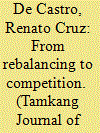|
|
|
Sort Order |
|
|
|
Items / Page
|
|
|
|
|
|
|
| Srl | Item |
| 1 |
ID:
166119


|
|
|
|
|
| Summary/Abstract |
During his two terms as U.S. president, former President Barack Obama made the Asia- Pacific region the focal point of American strategic attention. In November 2011, he announced the U.S. pivot to Asia. His goal was to constrain China from easing out the U.S. as East Asia's strategic offshore balancer. Contrary to expectations, the 2016 election of Donald Trump, did not spell the end of the strategic rebalancing to Asia. For the Trump Administration, the Asia-Pacific remains a top security priority for two reasons. One, North Korea's nuclear weapons program poses a clear and present danger to the U.S. and its allies in Northeast Asia. And two, China's naval expansion, island-building activities, and militarization efforts in the South China Sea threaten not only the freedom of navigation but also the rules-based international order. In conclusion, the article argues that there is a great deal of consistency between the Obama Administration's strategic rebalancing and the Trump Administration's emerging Indo-Pacific Strategy. However, the current administration's Indo-Pacific strategy reflects both continuity as well as discontinuity with its predecessor's rebalancing policy. On the one hand, neither U.S. national security interests nor Asia's importance to Washington has changed in the Trump Administration. On the other hand, its policy also reflects discontinuity as it characterized China as a threat to U.S. interests and is geared to engage this emergent power in a long strategic competition in the Indo-Pacific region.
|
|
|
|
|
|
|
|
|
|
|
|
|
|
|
|
| 2 |
ID:
166121


|
|
|
|
|
| Summary/Abstract |
The general assumption of people that youth unemployment causes conflict situation lacks direct linkage, instead, numerous intervening factors affecting the lives of young people created frustrations and sense of grievances; and youth faces barriers in acquiring education and job opportunities in the labour market. The situation also surfaces over the varied socio-cultural differences of the youth along gender inequality, ideological, class, religion and geographical location with politicians playing to the gallery of these differences. Youth bulger theory is utilised to relate the implications of teaming population increase, insufficient food supply, high prices, reduction is purchasing power leading to social unrest. However, in-depth interview and focus group discussion was employed by the researcher giving the need to explore the link between youth, unemployment, socio-political, economic issues and marginalization among the youth leading to inequality and structural violent conflict situation. Understanding the situation will simplify policy framework and responses initiatives by the stake holders.
|
|
|
|
|
|
|
|
|
|
|
|
|
|
|
|
| 3 |
ID:
166122


|
|
|
| 4 |
ID:
166123


|
|
|
| 5 |
ID:
166120


|
|
|
|
|
| Summary/Abstract |
This paper aims to examine whether the industrial development of South Korea has been transformed from the state-led developmental model towards the new balanced model as anticipated by the government after the 1997 Asian financial crisis. The new role of the state would surely transform under the new development model. However, the academic debate on what has been changed and its effectiveness remains. Our main research question is: in the pursuit of social equity and balanced development, has the role of the Korean state as well as institutional arrangements shifted? What factors influence the outcomes and obstacles? In summary, the South Korea state altered its role to decentralize resources to various private actors and delegate regional government and local agents, such as technology parks, research institutions, and universities. This initiative aims to promote endogenous growth through a bottom- up approach. Particularly, the approach for financial funding and technology transfer were derived from the United States neo-liberal method, namely, Silicon Valley model. However, the outcomes deviated from those expected. We conclude that path-dependent factors, such as chaebol-monopolized industrial structure and political cronyism issues, hinder the intent of such transformation.
|
|
|
|
|
|
|
|
|
|
|
|
|
|
|
|
|
|
|
|
|